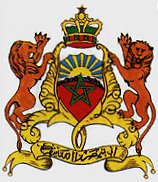INTRODUCTION
Morocco (Arabic Al Mamlakah al Maghribiyah), kingdom in North Africa, bounded on the north by the Mediterranean Sea,
on the east and southeast by Algeria, on the south by Mouritania, and on the west by the Atlantic Ocean. From 1912 to
1956 Morocco was divided into French and Spanish protectorates. The area of Morocco is 453,730 sq km (175,186 sq
mi).
II. Land and Resources
Morocco has the broadest plains and the highest mountains in
North Africa.The country has four main natural regions: an area of highlands, called Er Rif, paralleling the
Mediterranean coast; the Atlas Mountains, extending across the country in a southwestern to northeastern direction
between the Atlantic Ocean and Er Rif, from which the mountains are separated by the Taza Depression; a region of
broad coastal plains along the Atlantic Ocean, framed in the arc formed by Er Rif and the Atlas Mountains; and the
plains and valleys south of the Atlas Mountains, which merge with the Sahara along the southeastern borders of the
country. Most Moroccans inhabit the Atlantic coastal plain. The highest mountain is Jebel Toubkal (4,165 m/13,665 ft),
in the Grand Atlas range. Elevations in Er Rif attain heights of 2,450 m (8,040 ft). Morocco has many rivers, which,
although unimportant for navigation, are used for irrigation and for generating electric power. The chief rivers
are the Moulouya, which drains into the Mediterranean Sea, and the Sebou, which flows into the Atlantic Ocean.
A. Climate
Along the Mediterranean, Morocco has a subtropical climate, tempered by oceanic influences that give the coastal cities
moderate temperatures. At Essaouira (Mogador), for example, temperatures average 16.4°C (61.5°F) in January and 22.5°C
(72.5°F) in August. Toward the interior, winters are colder and summers warmer. Thus, in Fès the mean temperature is
10°C (50°F) in January and 26.9°C (80.5°F) in August. At high altitudes temperatures of less than -17.8°C (0°F) are
not uncommon, and mountain peaks are covered with snow during most of the year. Rain falls mainly during the winter
months. Precipitation is heaviest in the northwest and lightest in the east and south. The average annual
precipitation is about 955 mm (about 37.5 in) in Tangier, 430 mm (17 in) in Casablanca, 280 mm (11 in) in Essaouira,
and less than 102 mm (4 in) in the Sahara.
B. Natural Resources
Morocco's resources are primarily agricultural, but mineral resources are also significant. Among the latter the most
important is phosphate rock; other minerals include coal, iron, lead, manganese, petroleum, silver, tin, and zinc.
C. Plants and Animals
The mountainous regions of Morocco contain extensive areas of forest, including large stands of cork oak,
evergreen oak, juniper, cedar, fir, and pine.
Except for areas under cultivation, the plains are usually covered with scrub brush and alfa grass. On the plain of Sous, near the
southern border, is a large forest of argan, thorny trees found principally in Morocco.
Moroccan wildlife represents a mingling of European and African species. Of the animals characteristic of Europe, the fox, rabbit,
otter, and squirrel abound; of predominantly African types, the gazelle, wild boar, panther, baboon, wild goat, and horned viper are
common.
D. Soils
The soils along the coast of Morocco are halomorphic and humus-carbonate; inland areas have podzolic and steppe soils.
The southern part of the country is mainly desert.
E. Environmental Issues
Population pressures have led to soil erosion and desertification as marginal lands are farmed and ground cover is
destroyed by overgrazing. Morocco has a low rate of deforestation relative to other African countries, however, with
only 0.30 percent (1990-1996) of its forests destroyed each year. Forests cover 8.6 percent (1995) of the country's
area.
The country uses more than 90 percent of its fresh water for agricultural production. Available drinking water has been further limited
by pollution of freshwater sources with raw sewage and industrial waste. Periodic droughts contribute to water shortages in some areas of the country, and the problem of water scarcity is expected to worsen as Morocco's population continues to grow.
Reserves and national parks cover 0.70 percent (1997) of Morocco's total land area. The country is home to 39 threatened animal species.
Morocco has ratified international agreements protecting biodiversity, endangered species, wetlands, and the ozone layer.
The country has also signed treaties limiting hazardous waste and marine dumping.
|
